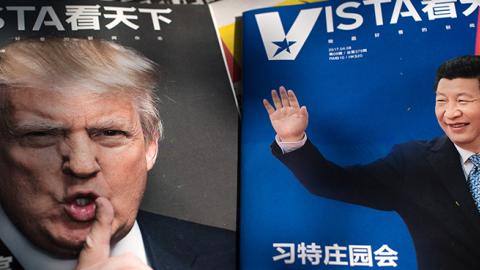China’s announcement that it will close down North Korean businesses in compliance with U.N. sanctions should not create unrealistic expectations about China’s sense of international responsibility. China has repeatedly proven expert at siphoning off pressures by appearing to change direction, without in the longer run changing much at all.
Appeals to “good global citizen” China too often mistake her ends. No nation has countered U.S. interests -- and related interests of its allies -- as widely and dangerously as China. The real world “outcomes,” in President Trump’s phrase, of China’s geopolitical, military, and economic policies pose serious dangers, including to the U.S. homeland. Neither American fuming about Korea nor China’s mid-October Party Congress appear likely to alter her long-term course.
“Principled realism,” President Trump has proclaimed, now guides U.S. policies. Based on this, he set new directions in Afghanistan and the Middle East. Principled realism requires understanding China’s actual goals and crafting new approaches to deal with them. Solving the Korean nuclear problem is best understood in this context.
Geopolitically, China seeks to drive U.S. influence out of Asia; and China’s hand has advanced the crises most bedeviling American interests there. For decades China has used Pakistan to its west, and North Korea to its east, to threaten regional rivals and the U.S. Chinese support to these troubled states has furthered their nuclear programs – and ultimately Iran’s -- and crippled U.S. non-proliferation policies.
The clever men in Beijing play their game skillfully, often stoking problems they pretend to condemn. Thus they distract China’s foes and increase leverage over them. China publicly scolds the North Koreans on nuclear threats her technology has aided, but encumbers America’s potential moves against them. Seeking bases, China funds Pakistan, even as President Trump tries to gut Pakistani support for terrorists endangering Afghanistan and America.
While the U.S. struggles to China’s east and west, Beijing seizes territories to the south. Defying international arbitration, she moves to intimidate Southeast Asia and swallow the South China Sea -- a critical and resource-rich trade route one fifth the size of mainland China -- foreswearing militarization there, even as she plans and builds military bases.
China presses decades-old complaints about Imperial Japanese aggression, even as armed Chinese patrols challenge democratic Japan’s long-recognized East China Sea territories. While still digesting Tibet, China advances forces into disputed territory along India’s northern border.
Militarily, China has dramatically increased anti-ship, anti-satellite, cyberwarfare, and intercontinental nuclear missile programs aimed at eclipsing U.S. presence in Asia. As U.S. naval presence weakens, Chinese forces may already deter U.S. engagement well-off China’s shores. A Chinese economy fueled in part through technology theft and questionable trade practices boosts her diplomatic clout and expansionist aims.
In many ways, China is a more formidable competitor than America has faced in half a century. True, China lacks the international ideological appeal that the Soviets once held, and her internal rifts are more apparent. But her economy is stronger, her technological capabilities greater, and her foreign commitments less burdensome.
America’s economy, meanwhile, lacks the ever-increasing heft of the headiest post-WWII era; its business community shies from losing Chinese markets; and its domestic and overseas commitments weigh heavily.
Accordingly, it is tempting to excuse China’s misdeeds as a natural by-product of her rising stature, or of fears of disruptions should neighboring autocrats collapse. Some seek solace in predictions of “inevitable” long-term pluralism moderating China’s arc.
However, for the foreseeable future, the real world trends worsen. Chinese President Xi is arresting rivals and consolidating power, not devolving it. Rather than mellowing, China’s actual policies repress intimidate Asia, spread China’s military reach, and shield nuclear and terrorist threats.
Four lessons from the Cold War might usefully set the framework for changing China’s strategic calculations. In the simple retelling, America’s bipartisan consensus and overwhelming nuclear arsenal curbed Cold War threats. The Trump national security team knows better. Deterrence and ultimate victory drew from pro-growth American economic policies, ready defenses that outpaced rivals, mutually beneficial alliances, and the resolute demonstration of American will in regions that, if lost, would augment adversaries’ geopolitical strength. This framework, often bitterly contested, constrained Soviet choices and hedged against the worst results.
Such efforts would improve U.S. positioning now, as well; and the Trump Administration appears to understand the importance of heading in this direction. Real regulatory and tax reform should, as in the Eisenhower and Reagan administrations, boost confidence at home, increase diplomatic clout abroad, and help the U.S. surpass geopolitical rivals. America need not spend today, as she did in the early Cold War, 9% or more of GDP on defense; but dramatically enhanced missile defenses, a robust fleet, and secure striking power will help reassure regional states and dissuade China from provocations that will only speed these trends.
President Trump reached out promptly to forge strong relationships with Japanese Prime Minister Abe and Indian leaders worried by, and willing to resist, Chinese maneuvers and bullying. His recent decisions on Afghanistan, Pakistan, and defense echo those made by prior presidents who persevered on costly, and often unpopular, courses to re-assert American will and advance America’s military edge. More will be needed.
The view from Beijing, not Washington, will drive China’s vision; only a comprehensive framework for shaping China’s future choices may bend her plans in directions less costly for the U.S. Longer term positioning is critical to winning and preserving even short term gains, and crucial to avoid future problems. Principled Realism recognizes that so long as ambition reigns there, China will not change course until geopolitical costs outweigh likely geopolitical gains.


















